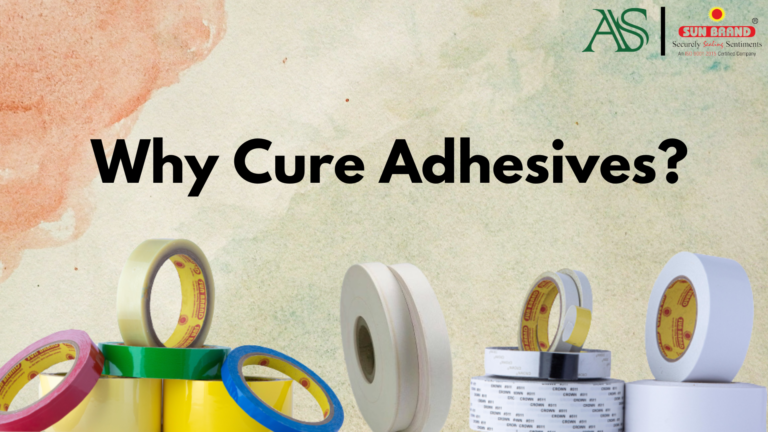In making any products there is a list of ingredients and a method of process required and pressure sensitive adhesive tapes are no different. This is a complex method for each type of tapes which can take pages to explain, but the basic formula for each tape may be similar.
What are the basics of Adhesive Formulations?
Pressure sensitive adhesives are viscoelastic, their properties are built by their base monomers and other additives.
What are the Base Monomers of an Adhesive?

Acrylic, rubber (synthetic/ natural), silicones, or hot melt adhesives are the base of adhesives.
1. Acrylic Adhesive: Acrylic adhesives are prepared by free radical polymerization of acrylic monomers such as acrylic acid, methyl acrylate, ethyl acrylate, 2‐ethylhexyl acrylate, methyl methacrylate and so on. They are formed by the free radical polymerisation of acrylic monomers. Acrylic can be solvent based and emulsion acrylic.
2. Rubber Adhesive: In pressure-sensitive adhesives, natural or synthetic rubber is used due to its excellent initial tack and ultimate adhesion, and they work well in low temperature applications. Rubber-based pressure sensitive adhesives are usually solvent-based or hot melt adhesives (even can be coated as an emulsion).
3. Silicone Adhesive: Silicone or polysiloxane are made upon siloxane (silicone-oxygen bond). Silicone adhesives offer good flexibility and exceptionally high heat resistance, that making them suitable for a wide range of applications in the electrical, electronic, automotive, aerospace and construction industries.
What are the Types of Chemical Used in an Adhesive Formulation?
Base monomers, hydrocarbons, accelerators, activators, tackifying agents, curing agents, and solvents additives are the main additives in an adhesive formulation.
1. Hydrocarbons: Hydrocarbon tackifier resins are thermoplastic resins that promote adhesion and tack in hot melt and pressure sensitive adhesives. These tackifying resins impact the final adhesive’s colour, stability, and odor. There are 2 types of hydrocarbon resins: C5 & C9.
C5 resins are aliphatic in nature and are, therefore, fully compatible with natural rubber, most olefins (LDPE) and many synthetic elastomers of low polarity.
C9 resins are aromatic in nature, are available in a wide range of softening points. Compared to C5 resins, they have a much higher melt viscosity, are of darker colour and have higher softening points ranging from about 100 to 150°C. C9 resins are very versatile resins that are compatible with many polymers.
2. Accelerators: Accelerators are added in the formulation to speed up the curing action between the catalyst and the resin. Accelerators are classified as primary and secondary. It is used along with a catalyst, curing agent or hardener to increase the rate of reaction, to lower the polymerization temperature, or to improve the efficiency of the reaction. They do not become part of the final molecule and don’t directly affect the final chemical or physical properties of the formulation. However, it may indirectly affect these properties by controlling the rate or order of competing reaction that occurs within the polymerizing system.
Sulphonamides, thiazoles (MBT, ZMBT), thiuram sulphides, dithiocarbonates (ZDEC,ZDBC) and guanidine are some of the rubber accelerators.
3. Activators: Activators are inorganic and organic chemicals used to activate the action of accelerators. These materials reduce the cure time by increasing the rate of curing. Initiators or activators are catalysts.
4. Initiators: Initiators are added to initiate the reaction. Catalysts remain unchanged in the curing reaction, causing the base monomer to crosslink and solidify. Sulphur compounds and peroxides are commonly used. Only small quantities are usually required to influence curing. 2, 2’Azobisisobutyronitrile (AIBN), tert‐Butyl peroxide, cumyl peroxide, benzoyl peroxide are examples.
5. Surfactants: Surfactants are used in both water-borne and solvent-based adhesive formulations. They are added to formulations to:
• Reduce surface tension
• Improve flow and wetting without negatively impacting adhesion
• Help to avoid defects occurring in the adhesive coating – especially on contaminated or difficult surfaces
• Improve flow
• Promote wetting and dispersion of additives
• Overcome foaming issues
• Stabilize the dispersion of polymer particles during emulsion polymerization.
Wetting agents, Antifoaming agents, defoamers, emulsifiers are some examples of surfactants.
6. Tackifiers: Tackifiers are low molecular weight compounds added to increase the tack and peel in pressure sensitive adhesive tapes. They are incorporated into base polymers which mainly lack tackiness and pressure-sensitive properties but provide cohesion. The three most important groups of tackifiers are hydrocarbon resins, rosin esters, and polyterpenes. Hydrocarbon resins are based on petroleum feedstock whereas terpenes and rosin esters are gained from pine trees.
7. Curing Agents: Curing is the process of crosslinking the molecular chains. They can change the physical and chemical properties such as hardness, tensile strength, elongation, thermal stability etc. The cross-links are formed by reaction of one polymer molecule with another or with a second polymer. These reactions can occur either at room or elevated temperatures, and there are catalysts that can accelerate the reaction mechanism. Cross-linking can be achieved either by applying radiation to the polymer or adding agents into the mix to promote chemical cross-linking. Amines, acrylates, peroxides, aziridines, isocyanates are some of the curing agents.
8. Additives: The bulk properties of Polymers can be altered by the incorporation of additives such as fillers, plasticizers, flame retarding agents, antioxidants, antiozonanats etc. The additives should be stable under processing conditions, not bleed or bloom and they should not adversely affect the properties of base formulation of the adhesive.
The selection of each ingredient in adhesive formulation depends on the compatibility, requirements, and the end properties.






